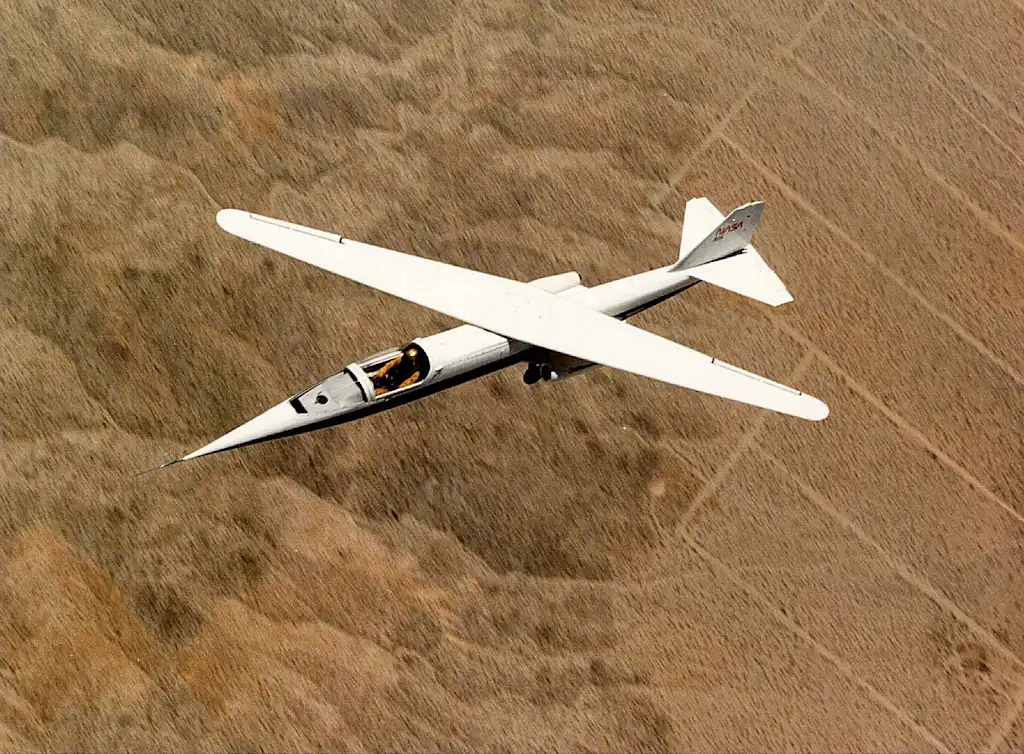China wants to build a hypersonic drone mothership from old NASA tech

China is taking a page from abandoned NASA research in an effort to leave the United States far behind in a new weapon category that the Pentagon believes will be crucial for military supremacy in the near future.
Beijing’s engineers have reportedly designed a hypersonic aircraft carrier—essentially a large, super fast drone mothership that can deploy several more drones. It uses an variable oblique wing, a historic, experimental design that has one single wing that rotates depending on the aircraft’s speed rather than fixed classical symmetrical wings in traditional planes.
To laymen used to regular aircraft it may look bananas, but the Chinese engineers believe that the design—originally created by Nazi engineers and continued by the U.S. in the second half of the 20th century—solves some of the key problems of hypersonic flight.
This will not be the first flying aircraft carrier. China has already built the Jiu Tian, a subsonic mothership capable of deploying a hundred combat drones. But it’s poised to be much faster than anything we’ve seen. According to defense experts, hypersonic flight is the key for the war of the future. While many intercontinental ballistic missiles fly at more than five times the speed of sound—the definition of hypersonic flight—they follow a predictable ballistic curve trajectory that make them easy to intercept for anti-air weapons like the Patriot batteries. But vehicles like this hypersonic craft will fly in unpredictable manners, like a regular airplane.
That combination of speed and flying pattern makes them virtually impossible to intercept. Effectively, this will enable this new Chinese aircraft to cross U.S. defenses carrying combat drones in its belly. Once this happens, it will be free to launch swarms of these drones to destroy key enemy infrastructure in the first minutes of a war.
Firing on all cylinders
It’s not the first time that China has snatched American weaponry designs. Decades ago, China systematically copied both U.S. and Russia’s devices to try to match their military prowess. In the last few years, however, Beijing has poured billions into university research labs, private companies, and its defense industry in a coordinated effort to turn the People’s Liberation Army into the most powerful and advanced force in the world by 2049.
China has have already leapfrogged the U.S. military in many regards, from advanced sixth-generation combat jets to hypersonic weapons that have no match in the American arsenal. One is their orbital hypersonic bombardment vehicle, a hypersonic glider capable of launching hypersonic missiles from low orbit. When its test was first detected by American agencies, then-Vice Chairman of the Joint Chiefs of Staff John Hyten said that it “defies the laws of physics.” The test was classified by General Mark Milley, then-chair of the US joint chiefs of staff, as “close to a Sputnik moment”, drawing a parallel to the nation-shocking Soviet Union’s achievement of placing the first satellite in space in 1957.
More recently, Secretary of Defense Pete Hegseth said that Chinese hypersonic missiles are capable of sinking all of the U.S. Navy’s nuclear aircraft carriers “in five minutes,” claiming that the U.S. loses all the Pentagon’s combat simulations against the Chinese army.
A future built upon the past
But even as China develops its own new wonder weapons, the Chinese haven’t stopped drawing inspiration from classic American breakthroughs to move forward, revisiting projects that the United States once deemed impossible for technical or economic reasons. Their aim: to discover new machines that will give them the upper hand against Washington in the event of a conflict.
We’ve already seen several prime examples of this trend, like China’s railguns—futuristic electromagnetic cannons capable of firing solid metal projectiles at hypersonic speeds up to 105 miles away using rails powered by massive electromagnets (a line of research abandoned by the U.S. Navy).
Another example is China’s oblique detonation engine, once an American invention from 1958 that promised aircraft capable of flying at sixteen times the speed of sound—about 12,000 mph—but was shelved when engineers failed to resolve its technical challenges. China has also deburred a design for a new hypersonic commercial and military aircraft that NASA left unfinished in the 1990s.
Now, China’s latest borrowed design is the oblique wing aircraft, a concept abandoned by the NASA in 1982. It’s getting a second life thanks to Beijing’s seemingly unlimited funding, and new computer tools that will make it possible according to this new work led by a team from Northwestern Polytechnical University that was published by Professor Ma Yiyuan in Advances in Aeronautical Science and Engineering in July.

Hypersonic carriers for combat drone deployment
The team has reimagined the oblique rotating wing to create a hypersonic unmanned mother ship—a near-space platform capable of Mach 5 flight that can dispatch drone swarms behind enemy lines. The proposed carrier operates at the edge of space (about 19 miles above Earth), carries up to 4,400 pounds of payload, and is designed to launch from 16 to 18 autonomous drones for rapid attacks on key enemy infrastructure, such as communication hubs, radars, and command centers, before air defenses can respond. After the strike, the aircraft would return and land under fully autonomous control.
The role of the oblique wing in this design is to solve one of aviation’s thorniest problems: How to achieve stable, efficient flight from takeoff at hypersonic speeds?
Unlike conventional aircraft—with their symmetrical swing-wing designs—the Chinese proposal centers a single wing that rotates up to 90 degrees. At low speeds, the wing is perpendicular for max lift. As speed ramps up, the wing pivots to 45 degrees, redistributing airflow and suppressing shock wave formation. At Mach 5, the wing aligns with the fuselage and merges into the top of the aircraft, transforming the entire vehicle into a “waverider”—basically a missile that breathes air and minimizes drag at hypersonic cruise speeds. At this point, the fuselage itself produces 67% of the lift, with the canards and the tail surfaces providing the rest via shock-induced pressure differences. The scientists claim this design achieves unprecedented aerodynamic efficiency in hypersonic travel.
Ma and his colleagues write in the research paper: “Compared to mainstream morphing configurations such as variable-sweep wings, the oblique wing aircraft features a relatively simpler structural design. The wing remains a single integrated component, and the wing box located at the centre of the configuration stays intact, providing significantly better load-bearing performance than conventional variable-geometry designs.” They also say that this architecture holds an advantage in structural strength.
But while simpler in structure, the design confronts severe engineering demands. The critical transonic transition—Mach 0.8 to 1.2—creates shifting shock waves along the wing, moving the aerodynamic center forward and potentially causing dangerous nose-down pitches that could make the craft uncontrollable. Here, the research highlights the need for a sophisticated array of control surfaces: nose-mounted canards and a high-mounted tailplane, which regulate downwash, front lift, and nose-up moments, all while vertical stabilizers actively manage roll and yaw as shock waves evolve.
This design was discovered thanks to computerized fluid dynamic analysis and AI tools that NASA—and obviously the Nazis—didn’t have at the time. Which is why “the oblique wing was ahead of its time but it won’t be forever,” as an unnamed spacecraft designer tells the Taiwanese newspaper South China Morning Post. Things like real-time strain monitoring, microsecond diagnostics, and fail-safe locking mechanisms for the wing’s central shaft will be key to handle the severe torque loads (the force that strains the fuselage and wing), thermal gradients (the temperature differences from the air particles’ friction at increased speed), and the general structural fatigue that arise in hypersonic flight.
Nazi Germany and NASA paved the way
As forementioned, the oblique wing isn’t a new dream. German engineers first sketched the concept during World War II. Richard Vogt, working at Blohm & Voss, designed the P.202—a jet fighter whose wing rotated obliquely, one side forward and the other back, balancing aerodynamic forces and aiming for a sweet spot between high-speed efficiency and low-speed lift. Though never built or flown, the design set the template for future asymmetric wing studies.
After the war, Dr. Vogt and the oblique wing theory crossed the Atlantic. American aeronautical engineer Robert T. Jones picked up the concept in the 1950s, conducting a series of analytical and wind tunnel studies at NACA (the National Advisory Committee for Aeronautics, the predecessor for NASA) Ames Research Center in California. These investigations revealed that a transport-size oblique-wing aircraft, flying at speeds up to Mach 1.4, would exhibit significantly improved aerodynamic efficiency compared to conventional aircraft designs.
By the 1970s, Jones and his colleagues moved from theory to hands-on experimentation. NASA built the Oblique Wing Research Aircraft, an uncrewed propeller-driven testbed, and later a small remote-controlled demonstrator aircraft with a 20-foot wingspan that flew once, demonstrating stable flight with wing sweeps from 35 to 50 degrees. These testbeds showed promise in drag reduction and fuel efficiency, but at high sweep angles, they exhibited unpleasant flight characteristics and pronounced roll-coupling modes, foreshadowing the challenges that would later surface.

The effort culminated in the only crewed aircraft to use the concept: the NASA AD-1 (Ames-Dryden-1), delivered to Dryden (now Armstrong) Flight Research Center in 1979. The AD-1 was built with a low-speed, low-cost philosophy—the design specified by NASA and detailed by Rutan Aircraft Factory. Constructed of plastic reinforced with fiberglass and a foam core, the squat aircraft had a fixed tricycle landing gear and was powered by two small Microturbo turbojets. It was limited to speeds of about 170 mph for safety reasons.
Over its three-year flight program (1979-1982), the AD-1 made 79 flights, its unique wing pivoting incrementally from zero to a full 60 degrees. The pilot would control the sweep using an electrically-driven gear mechanism inside the fuselage. Data collected throughout the envelope expansion revealed that, although the oblique wing was mechanically viable, significant challenges emerged—especially at sweep angles above 45 degrees. The aircraft developed problems that led to poor handling qualities and sometimes precarious flight behavior. The fiberglass structure’s limited stiffness exacerbated these tendencies, making improved control systems and stiffer materials a necessity for any future higher-speed designs.
NASA retired the AD-1 after fulfilling its research objectives. The aircraft never went beyond subsonic trials or into larger commercial or military applications, remaining an exhibition piece at the Hiller Aviation Museum in California. Subsequent plans for larger, transonic and supersonic oblique-wing aircraft—including airliners and DARPA’s Switchblade demonstrator created with Northrop Grumman—were canceled before reaching full realization, as engineers assessed that the control and structural challenges remained unsolved with then-existing technology.
Why China believes it will succeed
Despite these historical setbacks, China’s engineers argue that today’s advances—computational fluid dynamics, artificial intelligence, and smart materials—can finally make the oblique wing workable for high-speed strategic aircraft.
The engineering challenges at the core of the design are immense. The wing pivot shaft—a single hinge connecting the rotating wing to the fuselage—must endure tremendous bending moments during high-speed flight, often beyond the endurance of conventional aerospace materials. Torque demands increase with the square of velocity, and the motors that drive the wing must overcome significant aerodynamic resistance, particularly as speed climbs.
At Mach 5, leading-edge temperatures exceed 1,000 degrees Fahrenheit, while the shaft remains inside the cooler fuselage, resulting in severe thermal gradients and stressing lubrication systems. Fatigue from repeated stress cycles poses another threat, risking microscopic cracks or catastrophic failure if the shaft breaches the pressurized cabin.
To address these risks, the Chinese team emphasizes redundancy: multiple backup systems, real-time strain monitoring, microsecond-level diagnostics, and fail-safe locking mechanisms designed to freeze the wing in a safe position should any fault emerge. Combined with self-regulating smart structures and rapid-response flight control electronics, these measures form the technological bedrock for China’s efforts to finally realize the oblique wing’s potential as a next-generation strategic weapon.
If they succeed, China wouldn’t be just resurrecting abandoned American experiments or Nazi-era ambitions for the sake of academic ego. It can really give them a huge edge against the U.S. By transforming the oblique wing into a hypersonic drone carrier, Beijing aims to deliver a new kind of strategic weapon—one designed to outpace and outmaneuver anything the Pentagon can field in the race for future military supremacy.
Even if China fails to make it happen, the research highlights how America is getting more and more behind Beijing. Chinese aerospace engineers have recaptured the daring spirit of the supersonic 50s and the Apollo program, coming up with new ideas and remaking old ones into new designs that the American industry—focused on quarterly reports, shareholder value, and convoluted Pentagon contracts—are simply not considering anymore.
What's Your Reaction?
 Like
0
Like
0
 Dislike
0
Dislike
0
 Love
0
Love
0
 Funny
0
Funny
0
 Angry
0
Angry
0
 Sad
0
Sad
0
 Wow
0
Wow
0




























































































